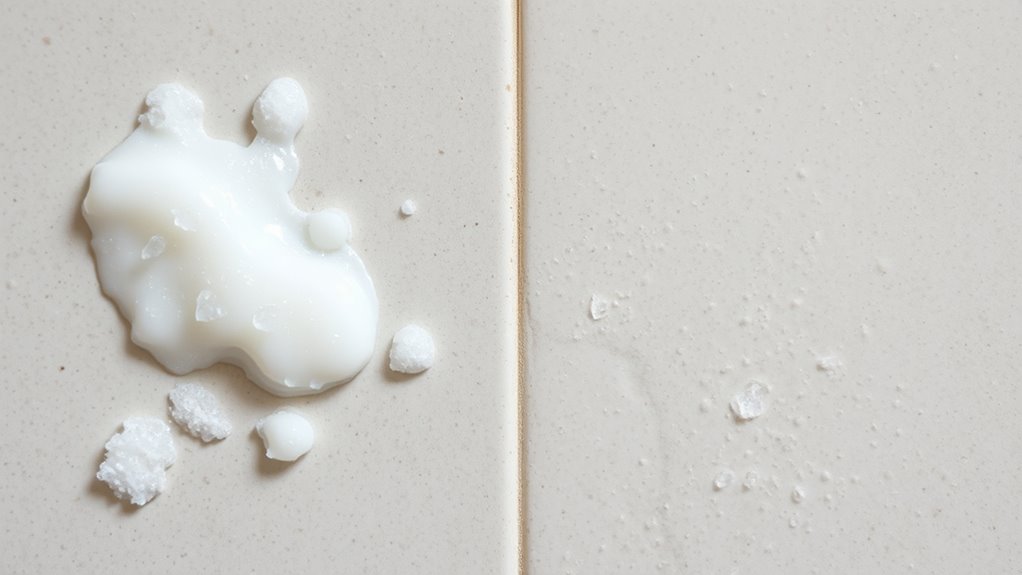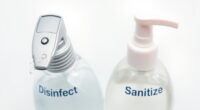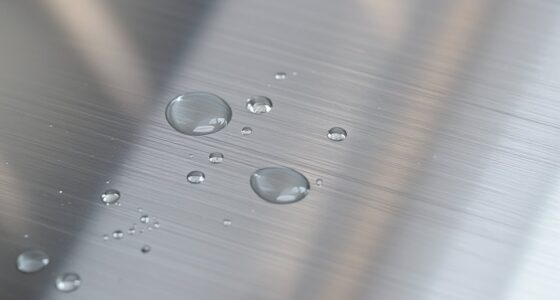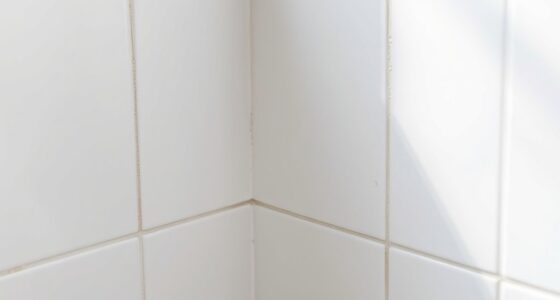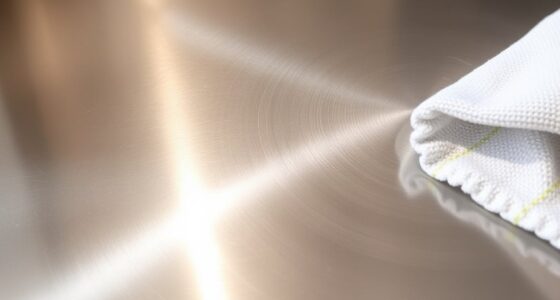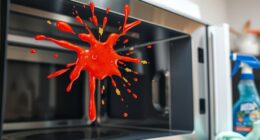Soap scum appears as a dull, chalky film on surfaces, forming when soap reacts with minerals in hard water, creating insoluble residues. Hard water stains are usually shiny, glassy deposits caused by mineral buildup. To treat the right problem, identify whether you see a soft, uneven film (soap scum) or mineral deposits (hard water stains). Understanding these differences helps you choose the best cleaning methods and prevent future buildup—there’s more to uncover to keep your bathroom spotless.
Key Takeaways
- Soap scum appears as a dull, filmy layer caused by soap reacting with minerals, while hard water stains are shiny, glassy mineral deposits.
- Soap scum is soft and layered with uneven edges; hard water stains are crystalline, more uniform, and often shinier.
- Signs of soap scum include a sticky film and difficulty rinsing; hard water buildup shows as mineral deposits and reduced water pressure.
- To treat soap scum, use vinegar, baking soda, or commercial cleaners; hard water stains often require water softeners or filtration systems.
- Proper identification ensures using targeted cleaning methods—vinegar for soap scum, water softening for mineral deposits.
What Is Soap Scum and How Does It Form?

Soap scum is a filmy residue that forms when soap reacts with minerals in hard water. This process involves chemical reactions where soap molecules, usually made of fatty acids, interact with minerals like calcium and magnesium. During the formation process, these minerals bond with soap, creating insoluble compounds that settle on surfaces. You’ll notice soap scum as a stubborn film on your shower doors, tiles, and sinks. It’s not just dirt; it’s a result of these chemical reactions that produce a sticky, chalky layer. Understanding this process helps you recognize why soap scum appears despite regular cleaning. The formation process is ongoing as long as hard water and soap are present, making it a persistent issue in many households. Additionally, the accumulation can be worsened by water hardness levels, which influence the amount of mineral content in your water.
How Hard Water Affects Your Bathroom Surfaces
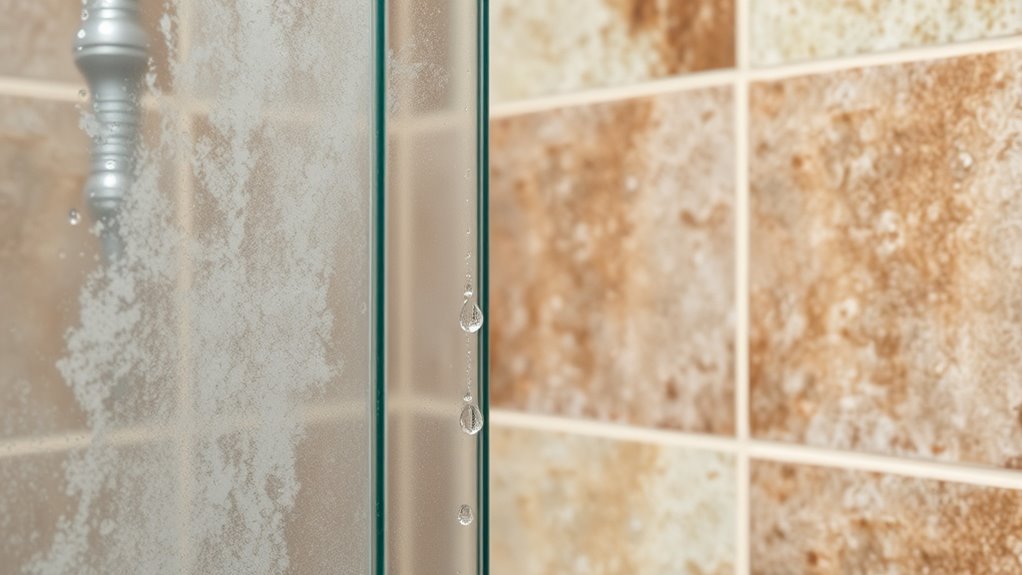
Hard water leaves mineral deposits on your bathroom surfaces, making them look dull and stained. Over time, these deposits can cause discoloration and stubborn spots that are hard to clean. Additionally, the minerals can corrode fixtures, leading to damage and costly repairs.
Mineral Deposits Build Up
When mineral-rich water flows over your bathroom surfaces, it leaves behind deposits that gradually accumulate over time. Calcium buildup is a common result of water mineralization, especially in areas with hard water. As the water evaporates, minerals like calcium and magnesium settle and stick to surfaces such as tiles, glass, and fixtures. Over time, these deposits form stubborn layers that can be difficult to remove. This mineral buildup not only dulls the appearance of your bathroom but can also cause surfaces to feel rough or uneven. Without proper treatment, the deposits can also lead to corrosion or damage to your fixtures. Recognizing the signs of mineral deposits early helps you take effective steps to clean and prevent further accumulation. Proper maintenance and using hard water treatment methods can help mitigate these issues and protect your surfaces.
Surface Discoloration Occurs
As mineral deposits build up on your bathroom surfaces, they often cause discoloration that’s hard to ignore. Hard water minerals leave behind stubborn stains that dull the appearance of tiles, glass, and fixtures. To combat this, you need effective cleaning techniques that target mineral buildup and surface stains. Regular surface maintenance, like wiping down after showers and using gentle descaling solutions, helps prevent discoloration from becoming permanent. Avoid harsh abrasives that can scratch surfaces; instead, opt for vinegar or commercial descalers designed for mineral deposits. Consistent cleaning not only restores the brightness of your surfaces but also prolongs their lifespan. Recognizing how hard water affects your bathroom makes it easier to develop a routine that keeps surfaces looking clean and vibrant. Understanding preservation efforts can further help you maintain the integrity of your surfaces and prevent ongoing damage.
Corrosion of Fixtures
Continuous exposure to mineral-rich water can cause your bathroom fixtures to corrode over time, leading to unsightly damage and deterioration. The corrosion of fixtures occurs when minerals like calcium and magnesium interact with metal surfaces, especially in areas with fluctuating water pH levels. If the water is too acidic or alkaline, it accelerates corrosion, weakening the metal and causing rust, stains, and pitting. Hard water’s high mineral content can also create a constant chemical reaction, breaking down protective coatings on fixtures. Over time, this results in fixtures that look worn and may eventually fail. To prevent corrosion, monitor your water pH levels and consider installing water softeners or filters to reduce mineral buildup and maintain the integrity of your bathroom fixtures.
Visual Differences Between Soap Scum and Hard Water Stains
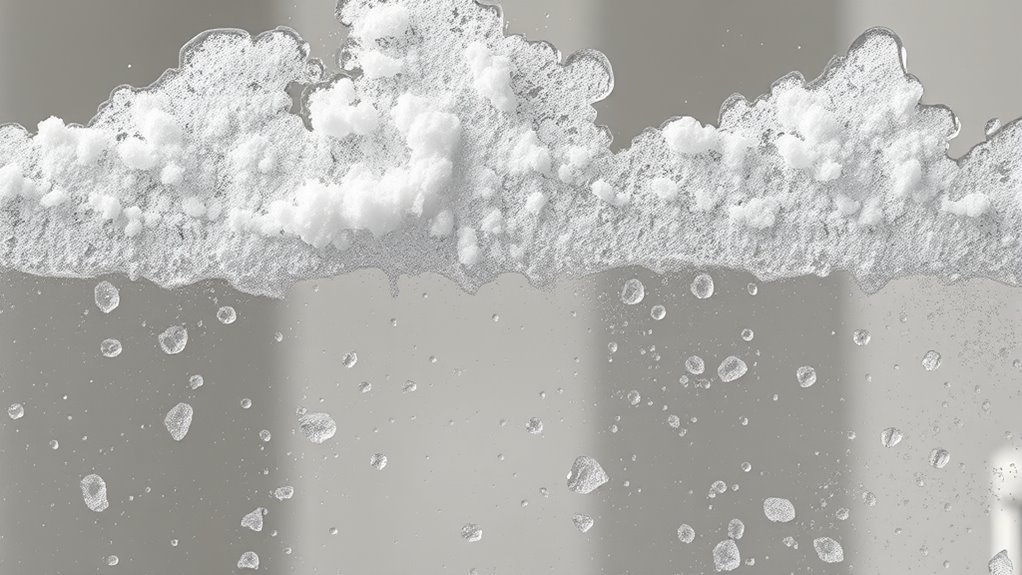
Although soap scum and hard water stains often appear similar at a glance, their visual differences are quite distinct. Soap scum typically forms a filmy, opaque layer with uneven edges, often appearing as a dull white or grayish residue. In contrast, hard water stains usually create a more uniform, mineral deposit with a shiny, glassy look. Their color variations can range from faint white to brownish or yellowish hues, depending on minerals present. To help you identify them quickly, here’s a comparison:
| Visual Cue | Soap Scum | Hard Water Stains |
|---|---|---|
| Texture | Filmy, soft, and layered | Crystalline, rough or smooth |
| Appearance | Opaque, dull white or grayish | Transparent to milky or mineral-rich |
| Edges | Irregular, uneven | Often more defined or uniform |
| Color Variations | Usually white or grayish | White, brown, or yellowish |
| Shine | Lacks shine | Usually shiny or glassy |
Additionally, understanding the environmental factors that contribute to these deposits can help in choosing the right cleaning method.
The Chemical Composition of Soap Residue and Mineral Deposits
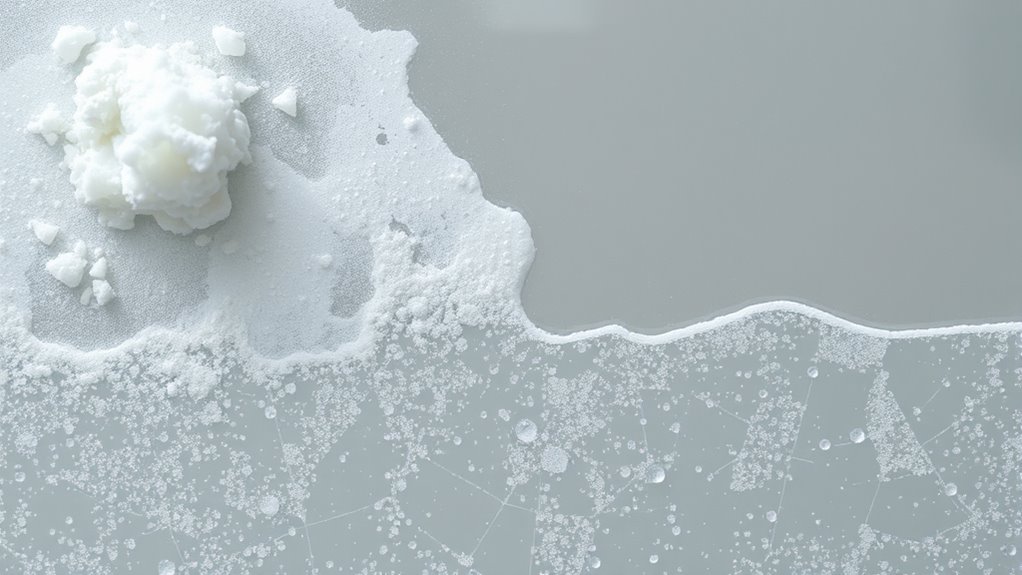
Understanding the chemical makeup of soap residue and mineral deposits is essential for effective cleaning. Soap residue forms when soap reacts with minerals in hard water, creating insoluble compounds called soap scum. Its chemical makeup mainly includes fatty acids and soap salts, which bind to minerals like calcium and magnesium. Mineral deposits, on the other hand, consist primarily of calcium carbonate and magnesium salts that precipitate out of hard water. These deposits adhere to surfaces, forming stubborn stains. Residue formation occurs when soap interacts with minerals, producing a film that clings to fixtures, glass, and tiles. Knowing these chemical compositions helps you choose the right cleaning agents and methods to break down and remove soap scum and mineral buildup effectively, restoring surfaces to their original condition.
Common Signs That Indicate Soap Scum Is Present
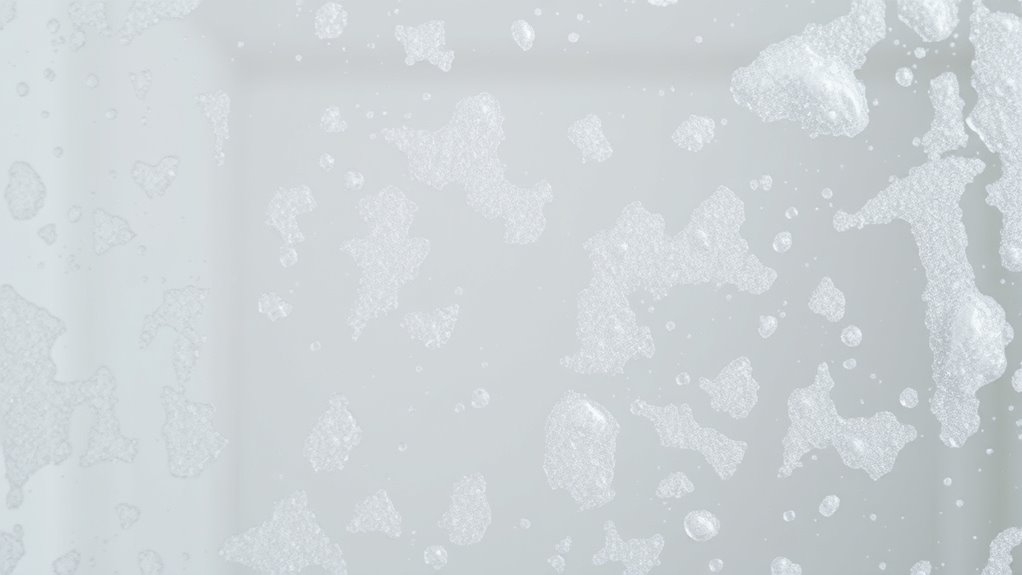
You’ll notice a whitish film building up on your fixtures and glass surfaces. Streaks of soap residue might also appear after cleaning or rinsing. If the water feels hard to rinse away completely, that’s a clear sign soap scum could be present. Additionally, keeping your workspace organized and decluttered can make it easier to spot buildup and maintain cleanliness.
Whitish Film Formation
A common sign that soap scum has formed is the appearance of a whitish film on your fixtures, glass, or tiles. This film often indicates limescale buildup caused by water hardness and soap residues reacting with minerals in your water. If you notice a cloudy layer that doesn’t wipe away easily, it’s likely soap scum. Hard water’s mineral content accelerates this process, creating stubborn deposits over time. Recognizing this whitish film early helps prevent damage and makes cleaning easier. Additionally, remote hackathons have become a popular way for teams to collaborate and innovate virtually, making it easier to address and find solutions for common issues like soap scum buildup.
Soap Residue Streaks
Soap residue streaks are a clear sign that soap scum has started to form on your surfaces. You might notice thin, greasy lines or streaks lingering after your cleaning routines. These streaks often appear on glass, tiles, or shower doors, indicating soap and mineral deposits building up. Recognizing this sign helps you adjust your lifestyle tips to prevent further buildup. To maintain clean surfaces, consider updating your cleaning routines with regular, thorough wipes. Using a squeegee after showers can reduce soap residue streaks. Avoid harsh scrubbing, which can spread the scum. Instead, opt for gentle, effective cleaners formulated for soap scum removal. Staying consistent with these habits keeps your surfaces clear and prevents soap scum from becoming a stubborn problem. Additionally, understanding the impact of hard water on soap residue can help you choose appropriate water softening solutions to minimize buildup.
Difficult to Rinse
When attempting to rinse surfaces affected by soap scum, you may notice that water beads and slides off slowly or leaves behind a filmy residue. This difficulty in rinsing is a common sign of soap scum buildup. It often occurs when your cleaning routines don’t fully remove residues or when water filtration systems aren’t effectively reducing mineral content. Hard water minerals can react with soap, creating a stubborn film that’s hard to wash away. If rinsing feels prolonged or leaves a cloudy film, it’s a clear indicator that soap scum is present. To improve rinsing, consider adjusting your cleaning routines to include more thorough rinsing or installing water filtration to minimize mineral deposits. This helps prevent soap scum from forming and makes rinsing easier. Utilizing water filtration systems can significantly reduce mineral buildup and improve cleaning efficiency.
Indicators That You Are Dealing With Hard Water
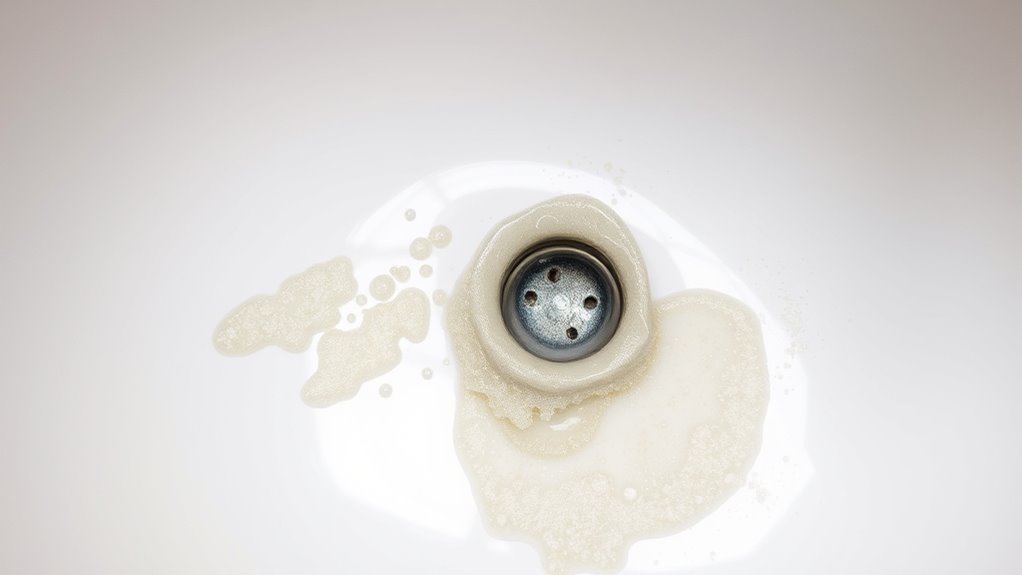
If you notice your soap doesn’t lather well or your skin feels dry even after washing, it’s likely a sign of hard water. Hard water contains minerals like calcium and magnesium that interfere with water softening processes and impact plumbing maintenance. Recognizing these indicators helps you address the problem early:
- Mineral deposits on fixtures and glasses
- Soap scum buildup on tubs and sinks
- Reduced water pressure in faucets
- Clothes feeling stiff after washing
- Frequent need for pipe repairs or clogging
- Cookie preferences can also influence how you manage and detect issues with water quality and home maintenance.
These signs point to hard water issues, which can be mitigated with water softening solutions. Identifying them early prevents costly plumbing maintenance and keeps your home running smoothly.
Effective Methods to Remove Soap Scum
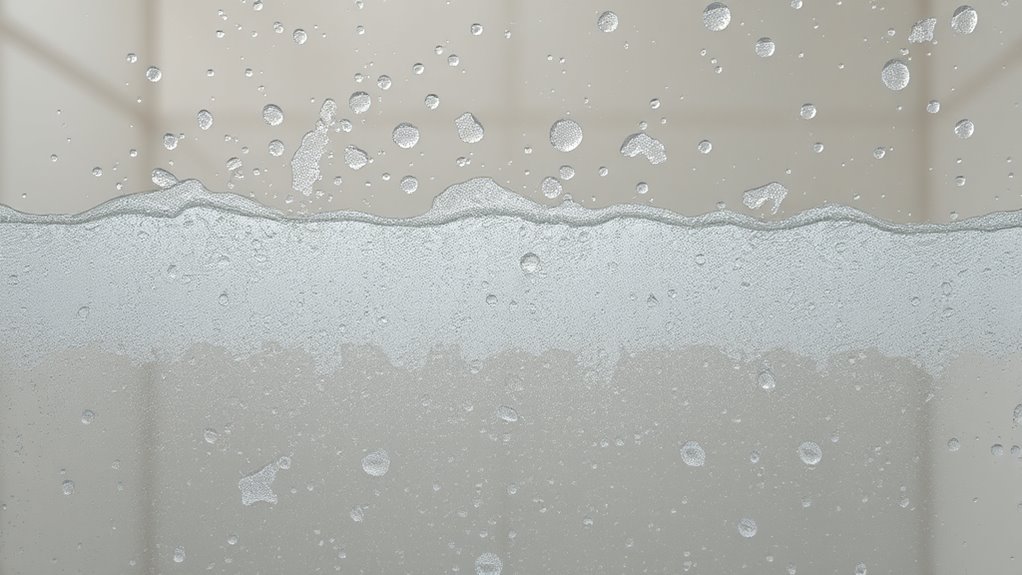
Recognizing the signs of hard water is the first step, but knowing how to effectively remove soap scum is what keeps your surfaces looking clean. Start by gathering the right cleaning tools, such as a scrub brush, a sponge, or microfiber cloths. For DIY remedies, a mixture of white vinegar and water works wonders; spray it on the affected areas and let it sit for 15 minutes before scrubbing. Baking soda is also effective when combined with vinegar or used as a paste. For stubborn spots, a commercial bathroom cleaner designed for soap scum can help. Always rinse thoroughly afterward to remove residue. Regular maintenance with these tools and remedies prevents buildup, keeping your surfaces spotless and soap scum-free. Studies show that proper water treatment methods can significantly reduce hard water deposits, making cleaning easier.
Solutions for Managing Hard Water and Preventing Stains
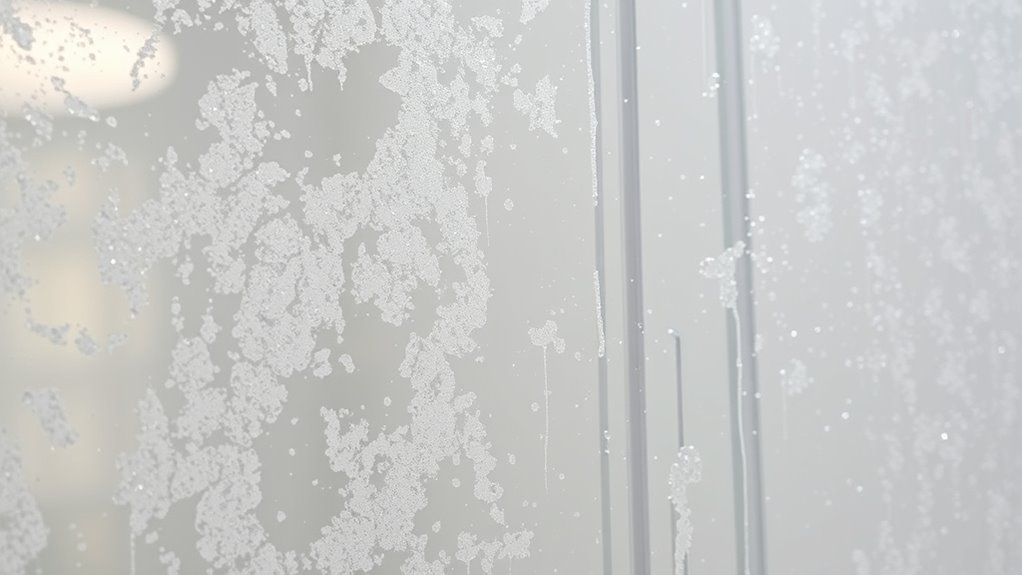
To effectively manage hard water and prevent stubborn stains, implementing proactive solutions is essential. Maintaining proper pH balance helps reduce mineral buildup and keeps water soft. Installing water filtration systems can remove excess minerals, minimizing stain formation and soap scum. Regularly cleaning fixtures prevents mineral deposits from accumulating. Using water softeners exchanges calcium and magnesium ions, softening water. You can also monitor water pH levels to keep them within suitable ranges, reducing mineral adhesion. Additionally, applying protective coatings on surfaces forms a barrier against stains. These strategies work together to keep your home cleaner and extend the lifespan of fixtures. Modern heat pumps can also contribute to maintaining optimal indoor conditions, indirectly supporting better water management by reducing humidity and preventing mold growth around fixtures. By combining water filtration, pH balance, and routine maintenance, you’ll effectively manage hard water and prevent unsightly stains.
Frequently Asked Questions
Can Soap Scum Cause Any Health Issues or Skin Irritations?
Soap scum can cause skin irritation and allergic reactions if it builds up on your skin or in your shower. When left untreated, it may lead to dryness, redness, or itching, especially for sensitive skin. You might also develop rashes or worsen existing skin conditions. To prevent these issues, clean your bathroom regularly and rinse thoroughly after washing. Taking these steps helps protect your skin from potential irritations caused by soap scum.
Are There Eco-Friendly Methods to Treat Hard Water Deposits?
Think of eco-friendly treatments as nature’s gentle touch for your hard water deposits. You can use natural remedies like vinegar, lemon juice, or baking soda to dissolve mineral buildup effectively. These methods are safe for the environment and your home, avoiding harsh chemicals. By choosing eco-friendly options, you not only treat hard water deposits naturally but also help protect the planet while keeping your space spotless and healthy.
How Long Does It Typically Take for Soap Scum to Build Up?
You’ll typically see soap residue begin to build up within a few weeks if you don’t clean regularly. The buildup timeline varies depending on water hardness and usage, but neglecting to clean can cause soap scum to accumulate faster. Regular wiping prevents the soap residue from becoming stubborn. To keep your surfaces clear, clean them at least once a week and use eco-friendly solutions to prevent excessive buildup.
Do Water Softeners Completely Eliminate Soap Scum?
Sure, a water softener sounds like a magic wand, but it doesn’t completely eliminate soap scum. Water softeners reduce mineral content, helping with soap scum prevention, yet some residue still lingers. They can’t totally wipe out soap scum, especially if buildup is already thick. So, while they improve your situation, you’ll still need to clean periodically—think of them as allies, not miracle workers, in your battle against soap scum.
Can Hard Water Stains Damage Plumbing Over Time?
Yes, hard water stains can damage your plumbing over time. The mineral buildup from hard water causes plumbing corrosion, leading to leaks or pipe deterioration. As mineral deposits accumulate, they restrict water flow and weaken pipe materials. You should consider installing a water softener or regular maintenance to prevent these issues. Addressing mineral buildup early helps protect your plumbing system from long-term damage and costly repairs.
Conclusion
Understanding the difference between soap scum and hard water stains is key to keeping your bathroom spotless. Did you know that over 85% of households in the U.S. experience hard water issues? By correctly identifying the problem, you can choose the right treatment and prevent future buildup. With the right solutions, you’ll save time and money while maintaining a cleaner, more inviting space. Take action today for a sparkling bathroom that truly shines.
